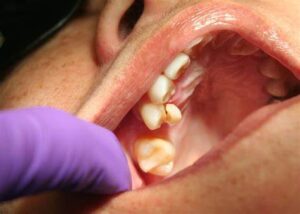What is it?
Tooth fractures occur when there is a break or crack in the hard tissues of the tooth, including the enamel, dentin, or pulp. These fractures can result from various causes, such as trauma, decay, or biting on hard objects. Depending on the severity and location of the fracture, treatment may range from simple restoration to more complex procedures like root canal therapy or extraction.
Here are some key points about tooth fractures:
- Types of Tooth Fractures:
- Craze lines: Minor surface cracks that affect only the enamel and do not usually cause symptoms or require treatment.
- Fractured cusp: A portion of the tooth’s chewing surface (cusp) breaks off, typically due to trauma or large dental fillings.
- Cracked tooth: A crack extends from the chewing surface of the tooth towards the root, but the tooth remains intact.
- Split tooth: A crack extends vertically through the tooth, separating it into distinct segments.
- Vertical root fracture: A crack extends from the root surface upwards towards the chewing surface of the tooth, often originating in the root canal.
- Horizontal root fracture: A crack extends horizontally across the root of the tooth, usually resulting from trauma or excessive force.
- Causes:
- Trauma: Direct trauma to the tooth, such as a blow to the face or a fall, can cause fractures.
- Biting on hard objects: Chewing on hard foods, ice, or non-food objects can lead to tooth fractures.
- Tooth decay: Decay weakens the structure of the tooth, making it more susceptible to fractures.
- Large fillings: Dental fillings that cover a significant portion of the tooth can weaken its structure and increase the risk of fracture.
- Bruxism: Chronic teeth grinding or clenching can exert excessive force on the teeth, leading to fractures over time.
- Symptoms:
- Pain when biting or chewing, particularly when releasing pressure.
- Sensitivity to hot or cold temperatures, especially if the fracture extends into the dentin or pulp.
- Visible cracks, chips, or breaks in the tooth surface.
- Swelling or tenderness of the gums surrounding the affected tooth.
- Diagnosis:
- Diagnosis of tooth fractures typically involves a thorough dental examination, including visual inspection, dental X-rays, and sometimes additional diagnostic tests such as transillumination or use of a dental microscope to detect fine cracks.
- Treatment:
- Treatment for tooth fractures depends on the type, location, and severity of the fracture, as well as the patient’s symptoms and oral health status. Options may include:
- Dental bonding: Minor fractures or chips may be repaired with tooth-colored composite resin bonding material.
- Dental crown: For more extensive fractures that compromise the structural integrity of the tooth, a dental crown may be recommended to restore strength and protect the tooth from further damage.
- Root canal therapy: If the fracture extends into the pulp chamber or root canal, root canal therapy may be necessary to remove infected or damaged tissue and seal the tooth’s interior.
- Extraction: In cases of severe fractures that cannot be repaired or if the tooth is non-restorable, extraction may be the only viable option.
- Prevention:
- To reduce the risk of tooth fractures, it’s important to:
- Wear mouthguards during sports activities to protect teeth from trauma.
- Avoid biting on hard objects, such as ice, pens, or fingernails.
- Maintain good oral hygiene practices to prevent decay and strengthen tooth enamel.
- Seek prompt dental treatment for any signs of decay, damage, or discomfort to prevent further complications.
In summary, tooth fractures can result from trauma, decay, or other factors, leading to pain, sensitivity, and compromised oral health. Treatment options vary depending on the type and severity of the fracture, ranging from simple restorations to more complex procedures like root canal therapy or extraction. Prevention measures such as wearing mouthguards, avoiding hard objects, and maintaining good oral hygiene can help reduce the risk of tooth fractures and maintain healthy teeth and gums. If you suspect a tooth fracture or experience symptoms such as pain or sensitivity, it’s important to seek prompt dental evaluation and treatment.

